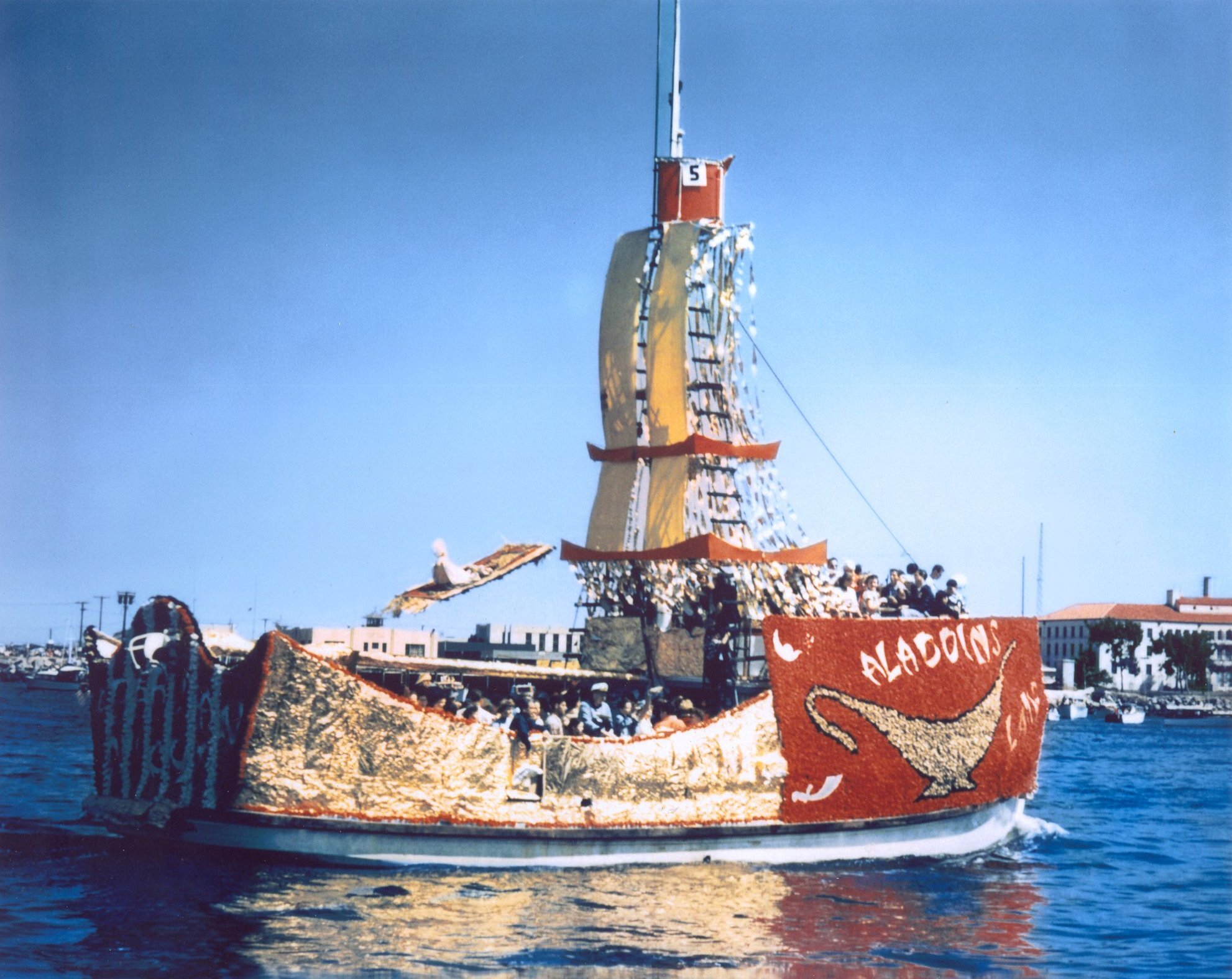Memories of the San Pedro Fishermen’s Fiesta by Marifrances Trivelli, Director, Los Angeles Maritime Museum
Memories of the San Pedro Fishermen’s Fiesta
by Marifrances Trivelli, Director, Los Angeles Maritime Museum
Many Palos Verdes Pulse readers still remember an annual celebration on the Port of Los Angeles Waterfront which drew hundreds of thousands of revelers during the 1950s and 1960s. The annual San Pedro “Fishermen’s Fiesta” was a combination of a blessing of the fleet, prayers for safety and success at sea, a demonstration of civic pride, and a treasured weekend to spend with family and friends. Although the Fiesta is no longer held, a look back provides the chance to recall a time when the largest fishing fleet in the nation was here in the Port of Los Angeles.
Part of the annual festivities included the selection of a “Fiesta Queen”, who was usually someone from a fishing family. This photo depicts the 1957 Fiesta Queen and her Court: from left: Lynn Husted, Frances McHale (Queen), and Juanita Gomes. (Los Angeles Maritime Museum Collection)
The 1957 Fiesta Queen and Court aboard the fishing boat SANTA RITA: From left: Juanita Gomes, boat owner Pete Guarrasi, Frances McHale (Queen), and Lynn Husted. (Los Angeles Maritime Museum Collection).
The Fiesta traditionally took place in September or October, between the end of the tuna season and the start of the sardine run. The origins of the Fiesta are a topic of lively debate, however the earliest documented celebration was the one held to mark the March 26, 1938 completion of the Fishermen’s Cooperative Association building. In honor of the event, eighty-five purse seiners (fishing boats) paraded through the harbor.
Reflecting the patriotism during the years following World War II, the fishing boat CITY OF NAPLES participated in a post-war boat parade with decorations reflecting military themes. (Los Angeles Maritime Museum Collection)
During World War II, recreational events on the waterfront were restricted, and no Fiestas were held until October of 1945. Over 100 boats participated in the “Victory Parade” honoring “the men who go down to the sea in ships and return to the land with fish”. The Fiesta grew in popularity, and by 1952 the crowds were estimated at 200,000. The colorfully-decorated fishing boats reflected the upbeat mood of the industry, with 700 boats and 5,000 fishermen gainfully employed in the harbor. On Terminal Island, 19 canneries employed 4,000 people. Five years later the Fiesta hosted the “world’s largest fish fry”, sponsored by the San Pedro Elks Club. This would be the last Fiesta before a 5-year hiatus, as the fishing industry would experience ongoing economic hardships due to rising tuna imports.
Archbishop James Francis McIntyre blesses the fleet in September, 1952.
In 1963 a Baptist minister from Wilmington, California sought to prevent Los Angeles County from spending public funds on the Fiesta, claiming that the festival had a “religious purpose” because it involved blessing the fleet and memorial services for fishermen lost at sea. The California Superior Court dismissed the case, and the Fiesta continued as scheduled.
At its peak, the Fishermen’s Fiesta attracted approximately 200,000 spectators. Fishing families, onlookers, and the media crowd the docks, circa 1950. (Los Angeles Maritime Museum Collection).
Through the years, the Fiesta’s success was tied to that of the fishing industry, and with the 1970s labor strikes, fuel shortages, and rising costs, the Fiesta began its gradual decline. A smaller, final attempt to revive the Fiesta took place in 2006. Today, though the San Pedro Fishermen’s Fiesta is no longer held, it is worth remembering as an example of the rich cultural life and maritime traditions of the harbor.
Often the boats were so heavily decorated that it was hard to identify them by name. Here the SANTA THERESA is disguised as Aladdin’s Lamp. (Los Angeles Maritime Museum Collection).
Fiesta Queen Rosheen Rayburn, First Mate Annamarie Olivas, and Second Mate Kay Barbee in the 1984 street parade. Rayburn credits her experience as Fiesta Queen for improving her public speaking skills. She recalled “Cardinal Manning gave me a microphone and had me help bless the Fleet!”. (Courtesy Rosheen Rayburn)
The photographs illustrating this article are from the collection of the Los Angeles Maritime Museum. Though temporarily closed to the public, the Museum continues to expand its presence online, by making its historic photograph collections available for everyone to enjoy. You can view more by visiting the Museum’s website at www.lamaritimemuseum.org, click on “research” and select “online collections”.
About the Author:
Marifrances Trivelli is the Director of the Los Angeles Maritime Museum, which preserves and shares the history of the Port of Los Angeles. She has a B.A. in Political Science from the University of Rhode Island, an M.A in History from the University of Connecticut, and is a graduate of the Getty Museum Management Institute. Marifrances is the President of the Council of American Maritime Museum, and serves on the City of Torrance’s Historic Preservation Commission. She invites all readers of the Palos Verdes Pulse to explore the Museum’s website www.lamaritimemuseum.org, and to visit in person once the Museum re-opens next year.









